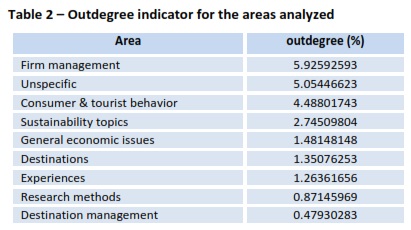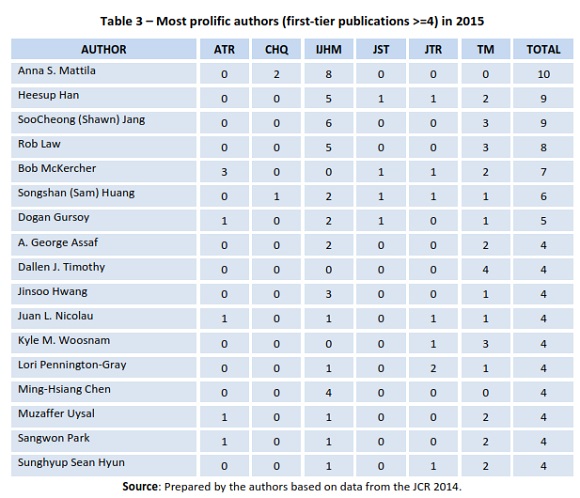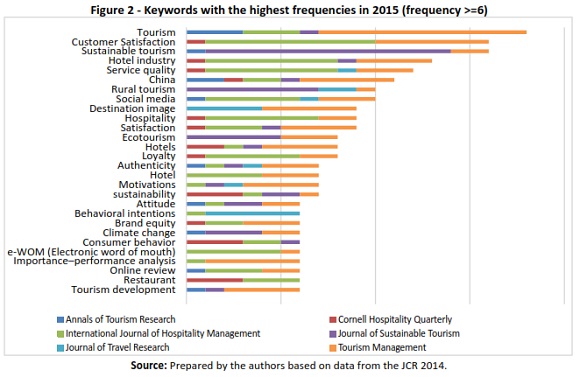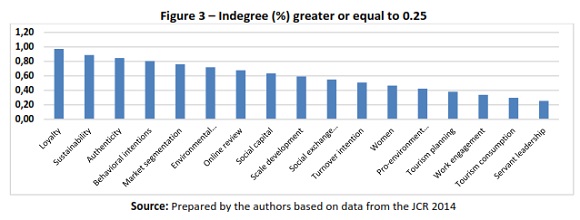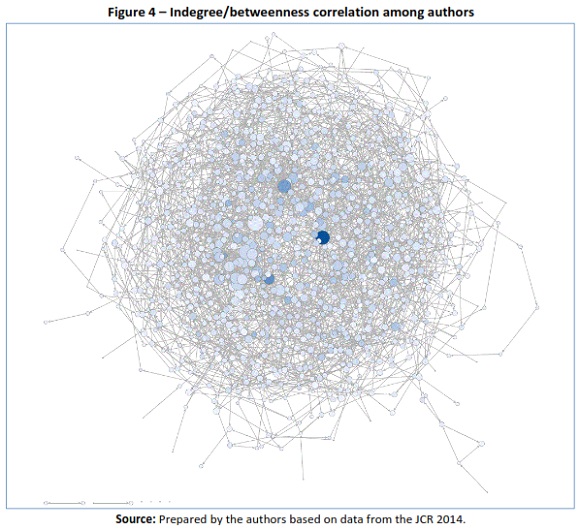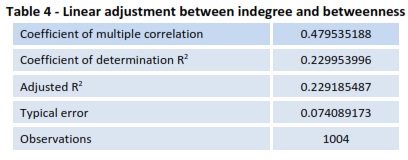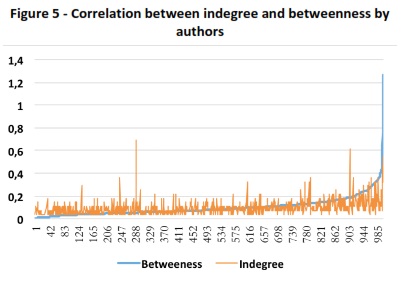Serviços Personalizados
Journal
Artigo
Indicadores
-
 Citado por SciELO
Citado por SciELO -
 Acessos
Acessos
Links relacionados
-
 Similares em
SciELO
Similares em
SciELO
Compartilhar
Tourism & Management Studies
versão impressa ISSN 2182-8458versão On-line ISSN 2182-8466
TMStudies vol.13 no.1 Faro mar. 2017
TOURISM - SCIENTIFIC PAPERS
The usefulness of social media analysis within scholarly publications: a study of first-tier tourism journals
La utilidad del análisis de redes sociales en las publicaciones académicas: un estudio de las revistas de turismo del primer cuartil
Antonio Peláez-Verdet*, Manuel Ferrera-Blasco**
*Universidad de Málaga, Facultad de Turismo, C/ Leon Tolstoi, 4, Despacho 12, 29071, Málaga, Spain, apv@uma.es
**Universidad de Málaga, Facultad de Turismo, C/ Leon Tolstoi, 4, Despacho 12, 29071, Málaga, Spain, manuelferrera@uma.es
ABSTRACT
The introduction of social network techniques in scholarly research analysis has driven a better understanding of the main authors and their debates. These tools have improved the traditional bibliographic models considerably. The present analysis applied the centrality indicators from social network analysis to first-tier journal articles (index: Journal Citation Reports (SSE)). The results revealed that journal specialization within the tourism theme is consistently in line with their editorial line, with minor issues detected. When it comes to academic debate, however, the topics are not concentrated homogenously. The authors at the center of the debate are not always the most prolific, yet it turns out that co-authoring helps them to gain central positions within the debate.
Keywords: Social media, tourism, first-tier journals, author networks, literature review.
RESUMEN
En el análisis de la literatura científica, los principales autores y sus debates han podido analizarse mejor desde que se han importado las técnicas de análisis de redes sociales, que mejoran las herramientas de bibliometría tradicionales. Este análisis ha aplicado los indicadores de centralidad del análisis de redes sociales a los artículos de investigación publicados en revistas de turismo de primer cuartil del Journal Citation Reports (SSE). Los resultados revelan que la especialización de las revistas, aún dentro de la temática del turismo, responde a sus líneas editoriales con algunos matices, aunque las inclinaciones en cuanto al análisis de las materias turísticas no se distribuyen de manera tan homogénea. Los autores que ocupan el centro del debate académico no siempre coinciden con los más prolíficos, aunque podría decirse que la coautoría ayuda a los autores a posicionarse en el centro de la discusión.
Palabras clave: Redes sociales, turismo, revistas de primer cuartil, redes de autores, revisión de la literatura.
1. Introduction
Literature analysis is an essential part of scientific research. Not only does it enable authors to situate themselves at the center of the debate at the time they are carrying out their research, but it is also key to contextualizing the results and to proposing improvements in the models accepted and gradually perfected by the scientific community.
However, progress in any scientific discipline is not organized and planned, but rather it is based on relatively spontaneous contributions from community members. Research teams address issues and discard or accept hypotheses based on their capabilities, funding, skills, etc. Then the results are published in academic journals subject to broad bibliometric constraints, purporting to be a reflection of the quality of these magazines. In this process, researchers try to maximize their number of publications while journal publishers must maintain journal viability and position in the rankings. Thus, the phenomenon of scientific research in any field has been characterized by high competitiveness, which has made many authors wonder whether too much emphasis is being placed on instrumental issues (the impact factors for journals, the number of publications or citations for authors), distancing the scientific community from the more appropriate holistic perspective that it should maintain (Timothy, 2015). According to one of the most respected publishers and authors in the field of tourism, impact factor systems are necessary to the extent they allow research centers to evaluate themselves and their researchers, although they do not provide a complete picture of the quality of the research (Perdue, 2015). Another of the most renowned tourism researchers has noted the recent emergence of an increasing number of manuscripts of intermediate quality, or not directly tourism issues, being sent unrealistically to high impact journals (McKercher, 2015). This research, which is valuable for dissemination commensurate with its level, is often lost or becomes obsolete as it goes through a complex and lengthy review process, to which it has been incorrectly routed, for academic policy reasons. The emergence of Open Access journals has broadened and revitalized the debate (Hall & Page, 2015).
On the other hand, the Impact Factor Index is a measure on which there is debate. In the tourism sector it is worth emphasizing notes that have appeared on the issue, and express the need to use this measure carefully (Law & Li, 2015; Law, 2010; Poria, Schwartz, & Uysal, 2015). In addition, this issue is even more relevant in tourism research, as the authors lack the structures that other areas have at their disposal to guide research. We do not have an area or discipline as such which enables us to plan funding of our research under a national project, nor do we have a catalog of high priority issues for tourism research. Under these circumstances it would be easy for research to fall into a relative lack of coordination, with over-investigated subjects and fields saturated with analyses, while underserved niches would still remain offering important opportunities for researchers.
The aim of this article is to review and adapt a methodology to obtain an overview of the topics investigated in a given period (2015), within the results the first-tier journals have offered and, thus, respond to several questions: on which topics were first-tier results published in 2015? Who were the main authors in these journals? And finally: Are the authors at the center of the debate also the most prolific?
2. Literature review
In 2004, Ronald L. Breiger published a book chapter in which he described different ways of analyzing social networks (Breiger, 2004). At that time there were already technological phenomena that anticipated the emergence of a way of understanding the study of human relationships that would complement the social sciences in a very positive way. In 2007 this form of analysis was applied to the relationships observed in online social networks (Mislove, Marcon, Gummadi, Druschel, & Bhattacharjee, 2007), in the following years becoming almost a standard for some branches of sociology and economics, as shown by the various applications as presented by Takacs (Takacs, 2009). In 2009 this trend was strengthened with the proposals of Borgatti et al. (Borgatti, Mehra, Brass, & Labianca, 2009), who enriched social network analysis with concepts from physics, among other contributions. The following year, Sergey Dorogovtsev published a book on the subject that was extremely useful for social network analysts (Dorogovtsev, 2010). For this research, the use of centrality measures, which were presented and perfected in 2010 (Opsahl, Agneessens, & Skvoretz, 2010), has been critical. Later social network analysis has appeared in more technical fields of research, such as business operations (Kim, Choi, Yan, & Dooley, 2011).
In the tourism sector, the most recent uses of social network models have enabled applying them primarily to the analysis of user behavior when searching for travel information (Li, Yang, & Pan, 2015; Light, Almeida, Anacleto, & Silva, 2013). Another recent area of application has been the relationships between companies and the increasing role of innovation within their networks (Aarstad, Ness, & Haugland, 2015).
Analysis of the tourism sector research itself has not been an issue specifically addressed in the scientific literature, as from the beginning it was very clear that scientific journals on tourism were clearly organized in a hierarchical fashion by users based on knowledge criteria and perceived quality (McKercher, Law, & Lam, 2006). Beyond studies such as these, only a few authors have taken on the task of meta-analysis of scientific research. For example, there is evidence that the field of tourism research is dominated by co-authoring, generally by authors from different areas (McKercher & Tung, 2015). However bibliometric tools have their limitations. For an analysis that reveals patterns about large amounts of data, social network models are very useful and promising, although they are little used at the moment. One of the few contributions that have been made using this type of tool indicates that linguistic and geographical proximity facilitates co-authoring, and that women are finally taking a majority role in the overall scientific tourism production (Santos & Santos, 2016).
The methodology proposed in this work incorporates certain elements already tested in other fields of knowledge, and that make it novel in meta-research in tourism. Although the first recommendations for use of social networks were made in the 1960s, the emergence of software specially designed for the analysis of social networks did not appear until the 1990s, its use spreading from then on. At the end of the first decade of the new century, few but interesting works on the use of social network analysis measures were published for the study of bibliometric relations, arriving at the conclusion that the centrality measures of this analysis were useful and suitable for this, more so than others that had been used up to that point (Feeley, 2008; Leydesdorff, 2009; Radev, Joseph, Gibson, & Muthukrishnan, 2009). Later, in 2012, Fiala delved into this idea, using some of these techniques to deduce an underrepresentation of Asian scientific literature in CiteSeer (Fiala, 2012). Although undoubtedly, one of the contributions that best underlies the basis for the objectives of the present work is the work of Iwami et al (Iwami, Mori, Kajikawa, & Sakata, 2013), who proposed a similar analysis applied to the field of Industrial Engineering literature, with the aim of researchers having a tool on which to focus their research efficiently based on the research at that time. Other contributions have been made in this line, mainly through book chapters (van Eck & Waltman, 2014) or work already focused on the information available to researchers online (Talmale & Singh, 2015). These last three works inspired the methodology used in this proposal, which is based on combining the methodology traditionally used by Iwami and the authors who preceded him and adding the treatment of qualitative information obtained online, according to the specifications of Talmale and Singh.
Another innovation incorporated into this work is the collection of the previous information using qualitative analysis tools, which has simplified this task, thus obtaining much more reliable adjacency matrices than if the information had been written manually.
3. Methodology
To address the objectives of this study, the first thing that was done was to systematize all the research articles (501 in total) published in the first-tier journals of the Journal Citation Reports (2014, Social Sciences Edition), in the category of "Hospitality, Leisure, Sport & Tourism". Given that the sports area offers a lower concentration in the literature on tourism, it was decided to focus the analysis only on journals whose field of research focused specifically on tourism, mentioning in their title "tourism" or "hospitality". In this way, those in which the term "sport" or "exercise" predominated in the title and approach were discarded. The International Review of Sport and Exercise Psychology, la Journal of Sport & Exercise Psychology, Psychology of Sport and Exercise and the quarterly Journal of Sport and Health Science were discarded. As shown in Table 1, the following journals, mainly focused on the tourism sector, remained:
It is also necessary to underscore that the research articles chosen and systematized were those that were thus described in the different issues of the journals. Therefore, no press releases, literature reviews, research notes or any other types of content unrelated to the objective of this study were systematized.
Once obtained, the 501 articles selected were subjected to a qualitative analysis process with the help of Atlas TI software (Friese, 2013). In the one by one both the authors and the keywords of each article were noted. In this process a database of 1124 authors and 2011 keywords was generated. We worked with the starting hypothesis that keywords are always carefully chosen by authors to accurately describe the topic of their research.
Once this database was obtained, it was detected that there is a minority of very prolific authors, while the vast majority has hardly had a first-tier publication during 2015. As for the most used keywords, it could be said that the presence of some is natural and not surprising to the researchers, such as the word "Tourism" that was mentioned as a keyword 18 times. By contrast, other keywords with a similar frequency were less expected, such as "China" (10 mentions) or "Autenthicity,” (7 occurrences).
The volume of systematized information was subsequently loaded into a social network analysis program, as an adjacency matrix in a one mode network. The software in question (Visone, version 2.16) was designed to analyze networks from the point of view of the study of human relations in online or offline support. However, it is a tool to obtain very powerful measures of the elements of a social network (such as authors) that stand out in their relationships through others that barely have a presence with just a few elements of the network.. This analysis is carried out through two basic measures that are traditionally applied in this type of studies (indegree and betweenness), and are intended to describe and explain the processes that take place within the group.
However, the results in a first stage were quite difficult to interpret, since there was a large group of keywords that had only been proposed by a single article during 2015, and this generated a lot of noise in the network model. If the 2011 keywords had been introduced and represented, the network would be an inconclusive cloud. It was necessary to make a determination to keep (in a first instance) all authors, and to put them only in relation to those keywords that had been mentioned in at least two different articles, thus discarding 1,728 keywords that were only mentioned once. After removing the noise caused by keywords with a single mention, clarity and interpretive power was gained. The keywords were grouped by common themes in the following 9 categories: "Consumer & tourist behavior", "Destination management", "Destinations", "Experiences", "Firm management", "General economic issues", "Research methods", "Sustainability topics "and" Unspecific". Finally, the network was left with 1124 authors related to each other by co-authorship, and also with 283 keywords, leaving the network as shown in Figure 1:

(clique para ampliar ! click to enlarge)
There were authors who, in addition to not co-authoring, used keywords in 2015 that were not mentioned in any other work. Consequently, 121 authors appeared isolated from the network, since they did not propose any keywords in their publications that were shared by the rest of their first-tier colleagues during 2015, and in the network representation they appeared as singular points, without contact with the rest of the network either by co-authorship or by sharing keywords common to other studies. Working with the other authors who have common keywords, it is observed that there are still a certain number of researchers who occupy the peripheral posts of the network. This is because their topics do not play a particularly connected role with the general debate that takes place at the center of the cloud of relationships that has been represented. This was measured by designing the network so that each arrow from a keyword to an author corresponded to an occurrence of that keyword in an article by that researcher. The outdegree indicator measures the number of arcs that are emitted from each keyword to the authors who have used them when describing their research. In the network depicted in Figure 1, the size of the triangles representing keywords represents the percentage of total links (arcs or arrows) that they sustain with the authors, according to the calculated percent of the outdegree indicator for that keyword. As can be seen, there are authors who are very connected to these subjects, located at the center of the graph, while a considerable number of researchers occupy more eccentric positions. This positioning is due to the fact that they are linked to the network describing their research with terms rarely used among their peers, which makes their connection with the scientific debate weaker in terms purely relating to the keywords chosen to describe their research.
The proportion of topics covered was also analyzed using this indicator, which enables the creation of a profile of the areas addressed in the first-tier scientific literature in 2015, exhibited in Table 2:
4. Results
4.1 Descriptive analysis of the codes obtained
In the end, both authors and keywords were analyzed based on their rationale, or what is the same, the number of times they were registered (once for each article in which they appeared). Thus we were able to verify that the most prolific authors during 2015 in the first-tier JCR tourism journals were those shown in Table 3, whose research results have been disseminated in a concentrated way in two of the journals analyzed:
Considering the most repeated keywords as an indicator of the topics addressed in the articles, it can be deduced that the issues that worried the first-tier journals in 2015 were those related mainly to Asia and environmental topics, the analysis of consumer behavior, and innovation. It is striking to find some geographical references between the keywords, which have been included in Figure 2:
An analysis of this information leads to the conclusion that the first-tier journals cover a wide range of topics. However, it is clear that each publication maintains a well-defined line regarding the subject matter of its articles. For example, the IJST paid close attention in 2015 to issues related to rural tourism and ecotourism. On the contrary, the authors who published in the journal IJHM were especially interested in the hotel industry, quality of service, consumer satisfaction and social networks. TM and JTR concentrated a lot of activity on topics concerning destination image.
However, the previous frequency analysis is a limited way of approaching the analysis of the debate that is taking place in the published first tier forums. It does not take into account, for example, the number of people who are focusing on a specific line within the tourism theme, something that is already evident by using the outdegree indicator. These authors also maintain lines of investigation that are often divergent, creating subnetworks that deal with partial issues of problems previously studied with other research teams, in studies that used other keywords and with other authors. Although the real problem with the use of keyword frequencies is that they are univariate measures, which do not take into account their co-occurrence in the research contexts. For example, one of the most repeated keywords is Tourism, although it has such a cross-cutting use in many research articles that finding it is not indicative of a specific theme. Frequency analysis gives it high importance as a keyword, since many published articles include it as a descriptor. But its use is not concentrated in a specific area of research, diluting its co-occurrence with other keywords that describe very different topics. On the other hand, using indicators that take into account the co-occurrence of keywords, it is possible to obtain a more precise idea of which keywords are being used more eloquently by the authors. The indegree or betweenness indicators are clear examples of tools to more precisely describe the nuances of the debate and the main lines that the researchers are following to catalog their investigations.
4.2 Analysis of centrality using the indegree indicator
Degree centrality examines the relationships between authors and keywords. It consists of determining the magnitude of the relations that the network actor maintains with the other actors. A null indegree indicates no relation to the other members of the network, or more precisely no member of the network referring to a relationship with the actor on whom it is measured. In this case, the core keywords of the network (those most related to other actors) do not have to be the most mentioned as in the case of the frequency analysis in Table 3, which only counts once per article, rather they should be the most used in the network. That is, they are considered central themes because a greater number of authors have employed them as descriptors in their publications. Analysis of this in the network graph is displayed in Figure 3.
As can be seen, the keywords with a higher popularity index among the first-tier authors do not necessarily coincide with the most referenced ones. In other words, there appears to be a greater number of authors than one might think who describe their research with keywords that are not among the most frequent according to an analysis by article. This suggests that the indegree indicator is more appropriate for measuring the concerns of the academic community than the frequency tables.
4.3 Analysis of centrality through the betweenness indicator
This indicator does not measure the capacity of an actor in the network to interact, but rather to act as a connector of two other actors. The greater the possibility that one of the authors can connect two more, the greater the value of this indicator will be. In this case, we find that almost always the authors with the highest index of centrality are also the ones with the highest index of attachment to the rest of the community, as shown in Figure 4.
In this case, the dark color of each node indicates a greater degree of indegree for each author, which in turn is indicative of its position within the academic debate and the exchange that other authors have with him. In contrast, the size of the node is equivalent to its degree of betweenness, which measures the author's ability to serve as a link between other authors. That is, to the extent that an author is related to increasingly connected subnetworks, his betweenness index goes up. It would be expected that the main authors of the scientific literature, the largest nodes, would in turn be the darkest ones, since that would indicate not only that they publish in co-authorship with other authors, but also that they maintain relationships with other authors who, at the same time, are highly connected. This is, indeed, what is noticeable in some cases, although not always, since there is a group of authors who, despite being central to the debates, do not support an equally intense network of relationships. When betweenness and indegree indices are compared, what is obtained is a correlation and a graph described below with a very poor fit between both variables (see Table 4 and Figure 5). That is, it is not evident that indegree and betweenness indicators are associated.
5. Conclusion
The conclusions of the preceding analysis affect the journals, the authors and the descriptors of the research topics. In general, it can be said that the advantage of this study that, although still preliminary, enables a deeper understanding of a great cloud of data, measuring the relationships of the authors with each other and with the keywords that they themselves designate to identify their investigations. This allows for a different level of analysis than traditional methods, with the appearance of new forms of representing social structures.
However, there are two major limitations that this study still needs to address. The first is derived from the breadth of the research, since the conclusions are based on a study on the publications of the first tier. Second, the computer tools used have their own limitations in terms of flexibility and effectiveness, making the analyses more visual than quantitative. The first of these limitations is already being resolved, and before 2017, it will be possible to use this model to analyze data not only from the first-tier in 2015, but everything published in JCR tourism journals during 2015 and 2016, which will facilitate analysis of a much broader perspective and its evolution over time. The limiting factor of the software will have to be revised in order to be able to migrate the data to other programs with greater capacity for quantitative analysis, probably Nvivo for the qualitative analysis of the metatexts and Ucinet for the network modeling and analysis.
Recapitulating the conclusions, in the first place it could be said that there are no signs of deviation in the first-tier journals with respect to their scope and editorial line. Judging by the themes each journal presents, the areas are clearly differentiated, and although there are some overlaps in the field of research, the conjecture is that a more refined analysis, which will be carried out shortly, would reveal common fields of study approached from different methodologies or points of views. The main themes that have been advanced in the journals analyzed mainly respond to issues of business management or consumer behavior, followed by those related to sustainability. Nevertheless, there is a predominant category of nonspecific keywords, the use of which is widespread among researchers. These results suggest that the analysis of social networks applied to the scientific literature offers advantages that have yet to be explored, but in any case represents a valid and effective analytical approach.
The use of centrality indicators has been able to offer a new and more precise vision of the areas that the authors investigate most. A priori, a simple frequency analysis by article could lead one to think that the areas most investigated are those related to sustainable tourism, the hotel industry or quality of service. Nonetheless, the key words that define most of the authors' work, and which occupy dominant positions in the first-tier authorship network, have to do with somewhat different aspects of the tourism management process, such as loyalty, sustainability, authenticity and behavior. This analysis repeated over time and refined will be able to help future researchers to better base their contributions to each area, or find areas still needing be analyzed better. It has been demonstrated that the main authors of the field are tremendously prolific in their publications, concentrating their dissemination activity in specific journals.
In any case, what McKercher and Law have affirmed about scientific production is confirmed: the scientific field of tourism is dominated by co-authors rather than singular authors. We also support Santos' hypothesis about the importance of co-authorship in this area, although we could add to their conclusions that the central authors in the debate are not always the most connected with the rest, although the correlation between these two magnitudes has yet to be verified. It could also be added that, indeed, co-authorship is the predominant form of publication in the area, but in addition the analysis allowed us to conjecture why many of the authors who have been left out of the network are singular authors who have published in solo on subjects described with keywords not common to the rest. This conclusion can be applied by establishing the premise that it is even more advisable for single authors to undertake research topics already underway, describing their publications with keywords similar to those used by others. Otherwise, they are left out of the network and lose visibility. A future line of research will address the correlation between the index of citations that these authors receive and the similarity of their keywords with those of the rest of the scientific community and the moderating effect that co-authorship has on it.
REFERENCES
Aarstad, J., Ness, H., & Haugland, S. A. (2015). Innovation, uncertainty, and inter-firm shortcut ties in a tourism destination context. Tourism Management, 48, 354-361. doi:10.1016/j.tourman.2014.12.005 [ Links ]
Borgatti, S. P., Mehra, A., Brass, D. J., & Labianca, G. (2009). Network analysis in the social sciences. Science (New York, N.Y.), 323(5916), 892-895. doi:10.1126/science.1165821
Breiger, R. L. (2004). The Analysis of Social Networks. Handbook of Data Analysis, 505-526. doi:10.4135/9781848608184.n22 [ Links ]
Dorogovtsev, S. (2010). Lectures on Complex Networks. Oxford University Press. [ Links ]
Feeley, T. H. (2008). A Bibliometric Analysis of Communication Journals from 2002 to 2005. Human Communication Research, 34(3), 505-520. doi:10.1111/j.1468-2958.2008.00330.x [ Links ]
Fiala, D. (2012). Bibliometric analysis of CiteSeer data for countries. Information Processing & Management, 48(2), 242-253. doi: http://dx.doi.org/10.1016/j.ipm.2011.10.001 [ Links ]
Friese, S. (2013). Atlas.TI 7 User Manual. Berlin: Scientific Software Development. [ Links ]
Hall, C. M., & Page, S. J. (2015). Following the impact factor: Utilitarianism or academic compliance? Tourism Management, 51, 309-312. doi:10.1016/j.tourman.2015.05.013 [ Links ]
Iwami, S., Mori, J., Kajikawa, Y., & Sakata, I. (2013). Comparison of indicators to detect emerging researches using time transition in quasicrystals. In 2013 IEEE International Conference on Industrial Engineering and Engineering Management (pp. 48-52). IEEE. [ Links ]
Kim, Y., Choi, T. Y., Yan, T., & Dooley, K. (2011). Structural investigation of supply networks: A social network analysis approach. Journal of Operations Management, 29(3), 194-211. [ Links ]
Law, R. (2010). An Analysis of the Impact of Tourism Journals on Google Scholar. In Gretzel, U and Law, R and Fuchs, M (Ed.), INFORMATION AND COMMUNICATION TECHNOLOGIES IN TOURISM 2010 (pp. 333-343). doi:10.1007/978-3-211-99407-8_28 [ Links ]
Law, R., & Li, G. (2015). Accuracy of impact factors in tourism journals. Annals of Tourism Research, 50, 19-21. [ Links ]
Leydesdorff, L. (2009). How are new citation-based journal indicators adding to the bibliometric toolbox? Journal of the American Society for Information Science and Technology, 60(7), 1327-1336. doi:10.1002/asi.21024 [ Links ]
Li, J., Yang, M., & Pan, B. (2015). Network Analysis of Navigation Paths of Tourists’ Trip Planning and Power Structure of the Online Tourism in China. Asia Pacific Journal of Tourism Research, 1665(April), 1-15. doi:10.1080/10941665.2014.998249 [ Links ]
Luz, N., Almeida, A., Anacleto, R., & Silva, N. (2013). Collective intelligence in toursplan: an online tourism social network with planning and recommendation services. In Proceedings of the International Conference on Computer Science and Software Engineering - C3S2E ’13 (pp. 42-48). Retrieved from http://dl.acm.org/citation.cfm?id=2494444.2494449 [ Links ]
McKercher, B. (2015). Why and where to publish. Tourism Management, 51, 306-308. doi:10.1016/j.tourman.2015.05.012 [ Links ]
McKercher, B., Law, R., & Lam, T. (2006). Rating tourism and hospitality journals. Tourism Management, 27(6), 1235-1252. [ Links ]
McKercher, B., & Tung, V. (2015). Publishing in tourism and hospitality journals: Is the past a prelude to the future? Tourism Management, 50, 306-315. doi:10.1016/j.tourman.2015.03.008 [ Links ]
Mislove, A., Marcon, M., Gummadi, K. P., Druschel, P., & Bhattacharjee, B. (2007). Measurement and analysis of online social networks. In Proceedings of the 7th ACM SIGCOMM Conference on Internet Measurement - IMC ’07 (pp. 29-42). doi:10.1145/1298306.1298311 [ Links ]
Opsahl, T., Agneessens, F., & Skvoretz, J. (2010). Node centrality in weighted networks: Generalizing degree and shortest paths. Social Networks, 32(3), 245-251. [ Links ]
Perdue, R. R. (2015). The unintended consequences of impact factors on tourism research: Thoughts and comments. Tourism Management, 51, 303-305. doi:10.1016/j.tourman.2015.05.011 [ Links ]
Poria, Y., Schwartz, Z., & Uysal, M. (2015). IF you can keep your head: The unintended consequences of the Impact Factor on tourism research. Tourism Management, 51, 300-302. doi:10.1016/j.tourman.2015.05.010 [ Links ]
Radev, D. R., Joseph, M. T., Gibson, B., & Muthukrishnan, P. (2009). A bibliometric and network analysis of the field of computational linguistics. Journal of the American Society for Information Science and Technology, 1001, 41092-48109. [ Links ]
Santos, J. A. C., & Santos, M. C. (2016). Co-authorship networks: Collaborative research structures at the journal level. Tourism & Management Studies, 12(1), 5-13. doi:10.18089/tms.2016.12101 [ Links ]
Takacs, K. (2009). Social and Economic Networks. Journal of Artificial Societies and Social Simulation (Vol. 12). [ Links ]
Talmale, M. S., & Singh, S. N. (2015). Web-Based Information Resources on Scientometrics: A Study. International Journal of Information Dissemination & Technology, 5(4). [ Links ]
Timothy, D. J. (2015). Impact factors: Influencing careers, creativity and academic freedom. Tourism Management, 51, 313-315. doi:10.1016/j.tourman.2015.05.009 [ Links ]
van Eck, N. J., & Waltman, L. (2014). Visualizing Bibliometric Networks. In Y. Ding, R. Rousseau, & D. Wolfram (Eds.), Measuring Scholarly Impact: Methods and Practice (pp. 285-320). Cham: Springer International Publishing. doi:10.1007/978-3-319-10377-8_13. [ Links ]
Received: 15 May 2016
Accepted: 8 July 2016














